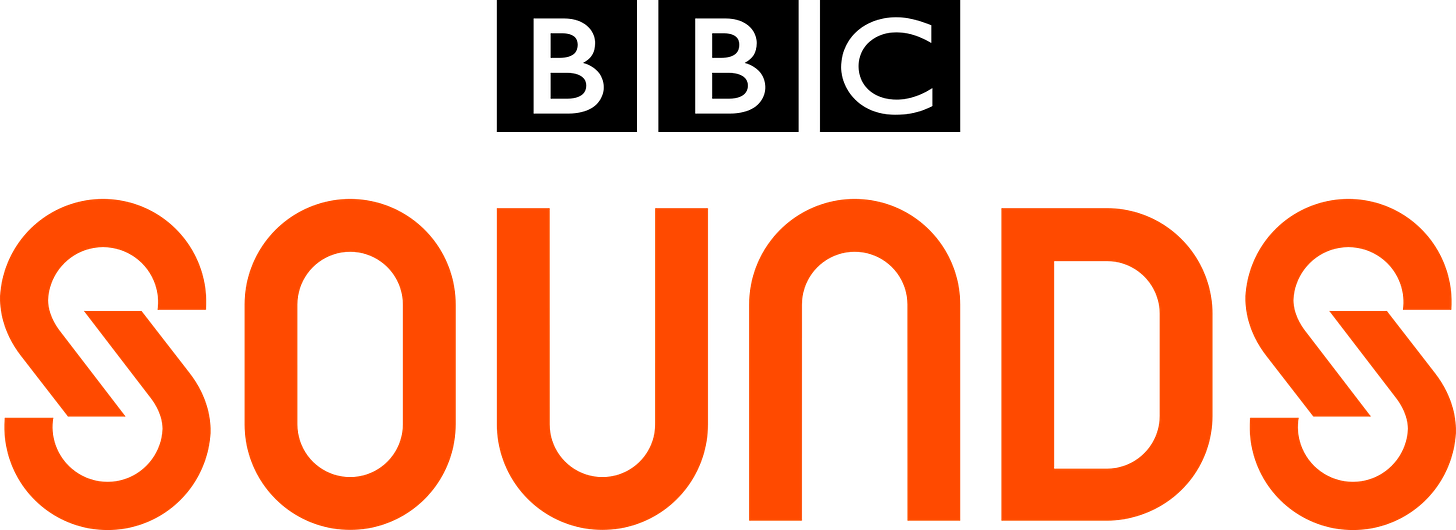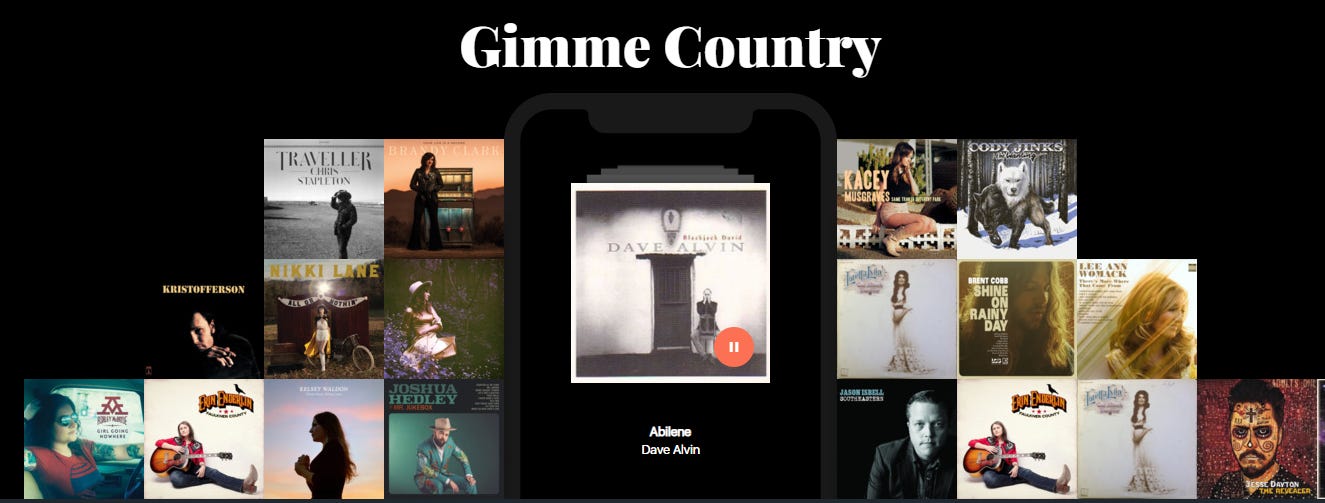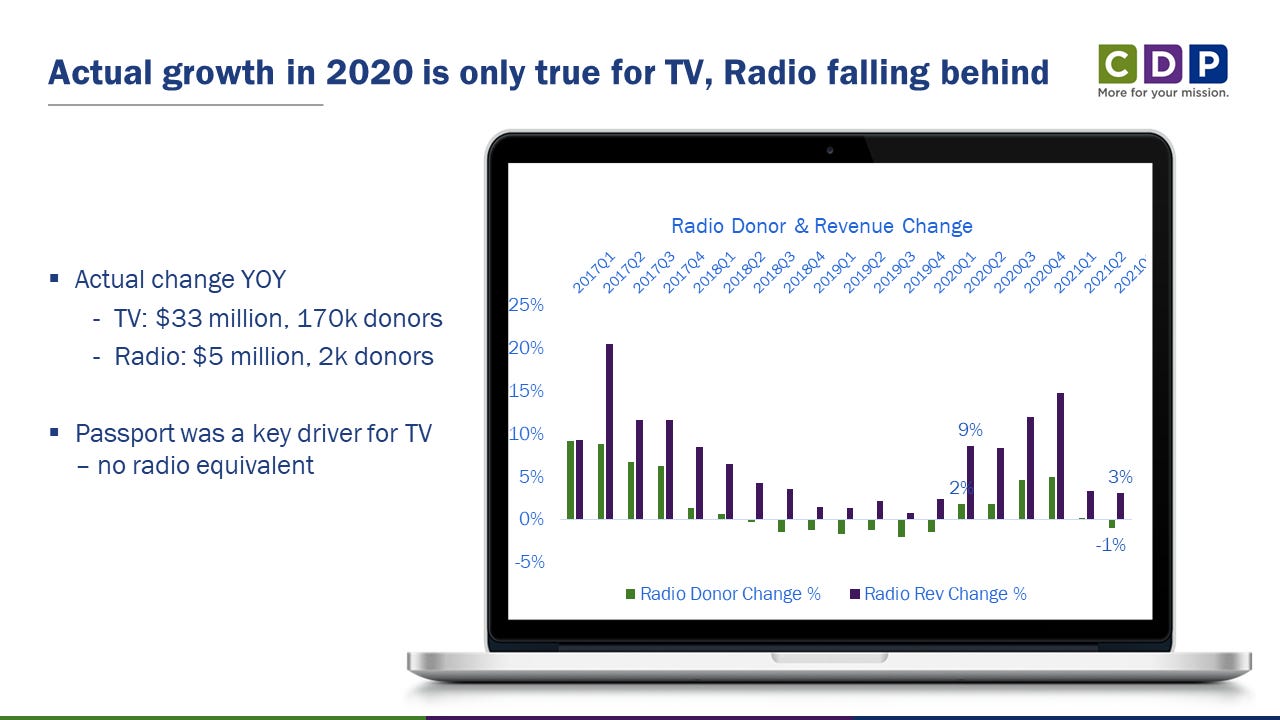Three Things for February 3, 2022
This week: Should NPR One be the best and first place to listen? And public radio music stations and social audio, plus things stations can do tomorrow to help bring in more new donors.
THING ONE: “The Best and First Place To Listen”
The Best and First Place to Listen is the headline from a post on the BBC website last week by Mary Hough, the Head of Content Discovery for BBC Sounds.
The piece explains an experiment that the BBC is trying to build an audience on the BBC’s own digital platform, branded as BBC Sounds.
BBC Sounds is an audio app for BBC content that’s sleek and built for easy use across the multiple services offered by “the Beeb.” That includes audio streams, music mixes, and podcasts. It became available for international users in September 2020.
Hough explains that in the four years that the product has been around, the BBC has launched several podcasts either available only or first on BBC Sounds, giving listeners easy access to them on the BBC’s own digital platform. In last week’s communication, Hough explained that in addition to its podcasts, beginning in March, they will make a small number of BBC radio programs available for on-demand listening first on the app.
“We want more people to use BBC Sounds to listen to their favourite BBC audio and to easily discover more from the BBC. This gives license fee payers even more value.
“Continuing to make BBC Sounds a success and increasingly valued by our audience is a priority for us. We think it’s vital to ensure brilliant UK content continues to thrive now and in the future. With more people listening on their mobiles, TVs and smart speakers, we want to make sure we’re helping create and deliver for the next generation of UK radio and audio fans.”
Hough adds that this is an experiment “to see what the impact is on listening on BBC Sounds, and we hope listeners do use this as an opportunity to try out Sounds and discover and enjoy more brilliant BBC audio.”
In the post, BBC Sounds’ Head of Content Discovery writes that “We know people have established ways of listening to on-demand audio but we also know many people already use multiple apps and platforms to listen to their favourite content.”
Hough closes the communication urging BBC listeners to download the app if they’ve never used it to give it a try.
The BBC has been working hard to keep content within its own distribution platforms, including blocking access to Google for some of its podcasts.

They have also pulled their radio streams from TuneIn.
Now I’m not going to suggest that public radio in the U.S. take that kind of extreme stance; however, the efforts by the BBC to build audience and use of the BBC Sounds app is an interesting experiment.
What if NPR and its member stations agree that as a way to increase usage and audience for NPR One, they jointly place a couple of NPR podcasts exclusively on NPR One for a limited time (perhaps a month similar to what the BBC is doing)?
Stations and NPR then promote the hell out of the shows and the platform as a test to see if the content on its own distribution platform could attract more users to the app.
The benefit of an experiment like this would be the user data that could be gained by a demonstration project like this one. At a time when many stations are struggling to bring in enough new members (see Thing Three) to replace the churn of lapsing donors, just getting a bunch of new email addresses to start acquisition efforts would be a worthwhile trial. The trial would also be a great opportunity to introduce NPR One to new audiences.
With The New York Times Audio app now in beta, the strategy to keep your content within your distribution platform is an essential move for public radio. PBS’s success with Passport could be a model for public radio, and we should be experimenting with our own distribution platforms.
Five years ago or so, at a public radio conference, a speaker suggested that “We need more control over the next digital platforms that touch listeners, as public radio stations do now. This is another reason why NPR One is so important.”
Yet, we have still not embraced that idea to the fullest. 2022 needs to be the year we do. If that happens, perhaps, for public radio, NPR One might very well be “the best and first place to listen” to public radio content.
Meanwhile, NPR has made a terrific hire as it builds out its strategy for its podcast subscription efforts. NPR Vice President of New Platform Partnerships, Joel Sucherman, shared the news in a note to staff that Leda Marritz is joining the company as the Program Manager for the NPR Plus podcast subscription service.
Marritz comes to NPR from Apple, where she was part of the Apple Podcast editorial team. After a brief stint with Pop Up Archive, an online platform start-up that focused on building tools to transcribe, organize, and search audio files, she joined Apple. Apple acquired Pop Up Archive in 2017.
In the staff announcement, Sucherman shared that Marritz will work closely with colleagues across the organization in Digital Media, Content Operations, Programming, News, and Member Partnerships on the growth and success of the NPR+ subscription service. He described NPR Plus as “both as a revenue stream for NPR and a path to station membership.”
I hope we’ll hear more about NPR Plus during the NPR Board meetings later this month.
THING TWO: Is Social Audio An Option for Music Stations?
Remember those early days of the pandemic with Zoom Happy Hours, sourdough starters, and binging on either “Tiger King” or the Michael Jordan documentary “The Last Dance?” One of those other experiences that exploded in those early days was the social audio app Clubhouse.
Clubhouse1 launched in March 2020 and went wild. A few months after its launch, it was valued at $1 billion and later in 2020 at $4 billion — which was insane. Two years later, the excitement over the app has lessened, although Twitter has copied the concept with its Spaces feature, along with Spotify’s Greenroom and others in social media.
Last fall, the independent music website Believe.com2 did a deep dive into how independent musicians use social audio during this time with decreased live performances and the fragmentation of marketing, making it an extremely challenging time for musicians to connect with audiences.
The piece, written by Dj and music producer Pablo Borchi, touched on four ways musicians are using live social audio conversations to their advantage:
Gathering knowledge and networking. The platform has been described as a “never-ending music industry convention.”
Creating meaningful interaction with fans. For example, one musician used Clubhouse by creating a virtual tour through different rooms of the app.
Making use of the new diversity in the social audio market to target the right audience. While Clubhouse was the first to market, artists are using copycat products to connect with fans in different ways through various alternative platforms.
Making the most out of the current social audio battle. For musicians, this means more competition opportunities are available from the various products to invest in musicians, giving artists the upper hand from a competitive standpoint.
The post concluded that, despite the fall of Clubhouse from its pandemic peak, social audio is here to stay and can serve as a crucial part of many artists’ direct-to-fan marketing tools.
So what does this have to do with public radio music radio stations?
Enter Gimme Radio and iHeartMedia.
Last week, news broke that iHeartMedia led a funding round of $3 million for the social audio start-up Gimme Radio.
Gimme Radio combines live and curated music shows that bands and their fans can set up as a virtual concert room. The audience can chat with each other during the show and share their digital reactions with others. When not performing, the bands and DJs can talk with their fans and promote their work. That includes directly tipping the performers and buying their merchandise and records.
The startup currently offers a channel for country music and a channel for metal music encompassing more than 1,200 artists.
The new investments into the company will most likely mean that they will be expanding into different genres, bringing in more artists, and finding a way to bring broadcast radio into the equation.
The involvement with iHeartMedia creates a new vehicle for this social audio start-up to deepen a connection with fans in communities across the country where iHeart’s radio properties bring a wide variety of music formats to audiences.
This kind of personal interaction between artists, fans, and radio seems like a great opportunity for public radio’s music stations. Over the past two years we’ve seen many public radio Triple A stations perform extraordinarily well, due in large part, to the deep local connections and companionship that they have with their audiences.
Innovative use of social audio might be an excellent strategy for stations to deepen that connection through a new platform. And perhaps, it might be an opportunity to use the existing partnerships within the Vuhaus Group to explore the best options to achieve this at a scale that stations can afford.
In a piece about the iHeartMedia investment in Voicebot.AI, Eric Hal Schwartz details how many players are moving into the social audio space focusing on the music.
“Clubhouse and its rivals in social audio have been quick to catch on to the potential for music and performance on social audio. That’s why the startup launched Music Mode’s improved audio quality and Spatial Audio’s mimicking of live events for the platform.
That’s also much of the thinking behind Spotify’s Greenroom social audio platform as it promotes new shows based on playlists. Similarly, Discord’s Stage Channels and its ongoing showcase of celebrities and events and projects is explicitly designed for performances. The same is true for Facebook’s new Live Audio Rooms and the upcoming Amazon social audio platform.”
Gimme Radio CEO Tyler Lenane told Schwartz in the Voicebot.AI piece, “Creating rich communities of artists and fans who can have meaningful conversations, build real relationships, and transact directly with one another is how the world will experience music and support artists.”
To me, this sounds like something that many public radio music stations do as part of their service.
Is Social Audio a place that music stations in public radio should consider as a new platform to better connect with artists and audiences? I’d love to hear your thoughts.
THING THREE: Things Stations Can do Tomorrow To Help Bring In More New Donors
A few weeks ago, I had the privilege to moderate a conversation with some super smart public media colleagues discussing what I think is a serious challenge facing public radio.
According to data from CDP’s National Reference File, while radio stations are still growing revenue, they have accomplished it for the last twelve consecutive quarters without increasing the number of current donors in the file. Retention has been strong, but public radio is not bringing in enough new donors to outpace attrition.
One of the panelists on the webinar, Melanie Coulson, the Executive Director of Member Station Services for Greater Public, explained that bringing new donors creates new contacts that expand the pipeline for mid-level and major gifts that can have implications for years to come for stations.
We also heard from Susannah Michaels, Off-Air Fundraising Manager with Wisconsin Public Radio, during the session sharing her experience with canvassing as a tool to bring in new donors. Many public television stations have been using the technique for several years with great success. Still, WPR is the only radio organization I know of to add this to their toolbox of donor acquisition. Susannah shared the results from their efforts, which have brought excellent ROI.
Greg Petrowich, the President and CEO with WFYI Public Media in Indianapolis, added his thoughts to the conversation bringing his perspective as a joint license. He shared some fascinating data tracking a six-year trend across his organization. As an organization, WFYI combines memberships across radio and television.
Greg reported new donors to WFYI from radio pledge have gone from 30% of the total new donors to the station in 2016 to 7% in 2019 to almost non-existent during the last two (COVID) years3.
Meanwhile, new donors from TV Pledge went from 44% in 2016 to 18% in 2021.
What has saved WFYI has been PBS Passport. Greg shared on the webinar that new donors to WFYI went from 0% in 2016 (Passport wasn’t around then) to 45% of the station’s new member acquisition in 2021.
That’s huge. This shift is reflected in the overall trend across public media, as displayed by the slide below from CDP.
You can see the full video from the January 19 webinar with this link.
To close out the session, I asked each panelist to offer “three things that stations can do tomorrow to help bring in more new donors,” and everyone had great ideas.
If you don’t make it through the entire webinar (although you should watch it!), here are the recommendations from the panel:
Susannah Michaels from WPR:
If NPR gives you prospects, email them. Many of those prospects will make gifts.
Add something you’re not already doing. For WPR, that will be some digital ads and search engine optimization to get in front of more people.
Retention is another way of growing your member file. She’s looking to re-activate WPR’s new member email welcome series in the hopes of renewing more of this year’s new members next year.
Greg Petrowich from WFYI:
Focus on your brand or the experience you provide as much or more than your content and start building a long-term plan for aggressive co-branding in places where a potential audience exists.
Study young people. Conduct some focus groups and make sure all the decision-makers from your organization are present for the conversations. You may think you know what younger audiences want, but chances are you don’t. And even if you do, it’s probably already changed.
Dashboard your qualified data file growth and make it as important as the overall revenue total.
Stephanie Patterson, Chief Customer Officer with CDP:
Use your prospect files to test smaller first-time gift amounts: the key is getting them to make that initial donation, even if it’s a nominal one.
Adopt an “always-on, always ready” membership approach - donors give on their timeline - is your website set up to provide those paths to giving year-round?
“But we’ve always done it this way” - remove those words from your vocabulary. Embrace change and encourage others to do the same.
Ken Siebert, General Manager and Jill Hirshi, Development Director with Yellowstone Public Radio4, Billings, MT:
“Swing for the fences.” Find partnerships and collaborations, both locally and nationally that can help your station grow without overtaxing a small staff.
Increase email communications and solicitations much more than you think you should. You may think you’ll offend a donor or prospect, but you probably won’t, and you’ll raise more money.
Be more aggressive in acquisition and renewals. Multiple efforts to bring in new donors and retain existing members bring great results for stations.
Melanie Coulson from Greater Public:
Add a clear call to action at the top of your donation page.
Do your own usability testing. For example, can you make a donation on your phone with one hand? Are you requiring unnecessary fields?
Make sure you’re using your confirmation page in an intentional way. Map out your cultivation and email post-donation journey.
My thanks to the panel for the great conversation. Also, thanks to the folks at CDP for hosting the webinar and the more than 115 people for joining and adding great comments and questions to the conversation.
There is some public radio connection to Clubhouse as back in September 2021, Nina Gregory, then the senior editor on NPR’s arts desk, joined Clubhouse as the new head of news and media publishers. She will be working with media brands on engaging with the Clubhouse community. Gregory is also tasked with helping news organizations use Clubhouse, connecting with journalists, and developing audio training opportunities at journalism schools.
This sounds like it should be Ted Lasso’s website!
Greg did note that the last two years have brought unique challenges to radio on-air pledge due to the pandemic.
Yellowstone Public Radio uses CDP’s Member Services Bureau allowing them to scale up their individual giving program.






